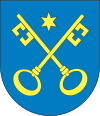 Alternate names: Ciechanowiec [Pol], Tshekhanovits and טשעכענאָווצע / טשעכאַנאָוויץ [Yid], Tsekhanovets and Цехановец [Rus], Chechanovitz, Chekhanovits, Chekhanovitse, Rudelstadt, Tsikhanovits. 52°40' N, 22°31' E, The River Nurzec divides the town into two unequal parts. The "Old City", spreading along the left bank, belonged to the Bielsk District of Grodno Gubernia of Russia; while the "New City" on the right bank belonged to Łomża Gubernia of Congress Poland. Between the two world wars, Ciechanowiec was in Białystok province of Poland, divided between the districts of Bielsk and Wysokie Mazowieckie. Jewish population: 1,498 (in 1897). Right bank (called New Town or "Polish section"), was part of the Polish Kingdom and the left bank Old Town ("Rus section") in Russia. November and January Uprisings left the right bank of Ciechanowiec lost the city rights in 1870. At the end of the nineteenth century, a textile industry developed in the city. Ciechanowiec also had very popular Horse Fairs. Significant damage from World War I nd the Polish-Bolshevik war were slowly repaired in the interwar period when the city was known to a large number of workshops, mainly Jewish.Before the beginning of World War II, 55% of the town's inhabitants were Jewish. In 1938, the two parts of the city were united. During World War II, the city was badly destroyed first by the soldiers of the Red Army, and since June 1941 by the German Army. The Jewish population was almost completely exterminated at Treblinka. After the war, reconstruction lasted a long time but the city has not regained its former importance and population. [August 2014]
Alternate names: Ciechanowiec [Pol], Tshekhanovits and טשעכענאָווצע / טשעכאַנאָוויץ [Yid], Tsekhanovets and Цехановец [Rus], Chechanovitz, Chekhanovits, Chekhanovitse, Rudelstadt, Tsikhanovits. 52°40' N, 22°31' E, The River Nurzec divides the town into two unequal parts. The "Old City", spreading along the left bank, belonged to the Bielsk District of Grodno Gubernia of Russia; while the "New City" on the right bank belonged to Łomża Gubernia of Congress Poland. Between the two world wars, Ciechanowiec was in Białystok province of Poland, divided between the districts of Bielsk and Wysokie Mazowieckie. Jewish population: 1,498 (in 1897). Right bank (called New Town or "Polish section"), was part of the Polish Kingdom and the left bank Old Town ("Rus section") in Russia. November and January Uprisings left the right bank of Ciechanowiec lost the city rights in 1870. At the end of the nineteenth century, a textile industry developed in the city. Ciechanowiec also had very popular Horse Fairs. Significant damage from World War I nd the Polish-Bolshevik war were slowly repaired in the interwar period when the city was known to a large number of workshops, mainly Jewish.Before the beginning of World War II, 55% of the town's inhabitants were Jewish. In 1938, the two parts of the city were united. During World War II, the city was badly destroyed first by the soldiers of the Red Army, and since June 1941 by the German Army. The Jewish population was almost completely exterminated at Treblinka. After the war, reconstruction lasted a long time but the city has not regained its former importance and population. [August 2014]
Ciechanowiec is a small town in Wysoczyzna Drohiczyńska, Gmina Ciechanowiec, Wysokie Mazowieckie County, Podlaskie Voivodeship, Poland. Wikipedia
- Ciechanowiec; mehoz Bialystok, sefer edut ve-zikaron
(Tel Aviv, 1964) - Iri Chekhanov = Iri Tchekhanovitsi
(Jerusalem, 1951) - Pinkas ha-kehilot; entsiklopediya shel ha-yishuvim le-min hivasdam ve-ad le-aher shoat milhemet ha-olam ha-sheniya: Poland vol. 4: Warsaw and its region
(Jerusalem, 1989)
- BialyGEN
- Museum of the History of Polish Jews
- Jewish Records Indexing Poland Town Page
- Słownik Geograficzny Królestwa Polskiego (1880-1902), I, pp. 677-679: "Ciechanowiec".
- Shtetl Finder (1980), p. 13: "Chechanovitz".
- Pinkas HaKehilot, Poland, Vol. 4 (1989), pp. 392-395: "Ciechanowiec".
- Encyclopedia of Jewish Life (2001), p. 260: "Ciechanowiec".
- We Remember Jewish Ciechanowiez [August 2014]
CEMETERY:
- Ciechanowiec had four Jewish cemeteries. The oldest of them, probably Middle Ages or 16th c., was at. Mickiewicz. Two other cemeteries, on the streets Uszyński and Mogilno, were closed to burial in the prewar period . All three cemeteries were completely devastated, only the cemetery at. Uszyński preserved section of the wall.
- ul. Sienkiewicz Cemetery: The last Jewish cemetery in Ciechanowiec was established in the eastern part of the city, south of the Catholic cemetery. This cemetery was severely damaged. After WWII and for many years, the area was used as an illegal sand mine with visible bones in the descecrated graves. In 2008, cemetery restoration work was carried out. Granite boulders mark the boundaries of the cemetery. A gate was built and a plaque placed. Behind the gate is set preserved tombstones. About 30 gravestones secured in the The Father Krzysztof Kluk Museum of Agriculture were discovered at various points in the city, serving previously to pave paths.
On November 4, 2008, the 66th anniversary of the liquidation of the ghetto and sponsored by the Foundation for the Preservation of Jewish Heritage in Poland a dedication of a memorial stone at the Jewish cemetery and a memorial tablet at the synagogue, a monument to the Jews executed by the Nazis, occurred. The Town Hall of Ciechanowiec and the Foundation for the Preservation of Jewish Heritage in Poland cooperated.
burial list and gravestone photos [August 2014]
photo and story [Sep 2014]
photos. [Sep 2014]
burial list [Jan 2015]
MASS GRAVE:
unnamed Jews were buried in the Catholic cemetery. [August 2014]
Debate Over Guilt : Poland: The Ghosts of Its Jewish Past May 16, 1987|STANLEY MEISLER. "A mass grave of executed Jews is marked by a low fence; another mass grave of executed Jews is unmarked and strewn with dead branches and refuse; a Jewish cemetery is now covered by young pine trees."
